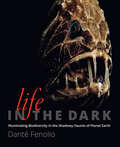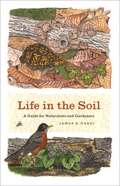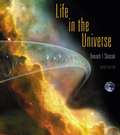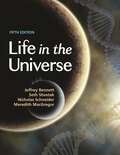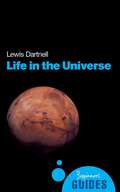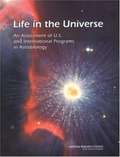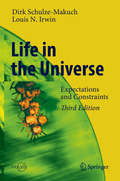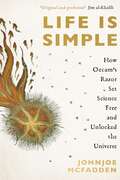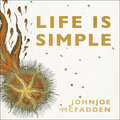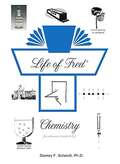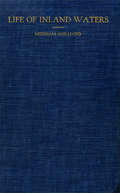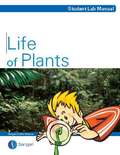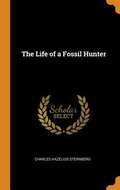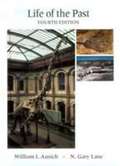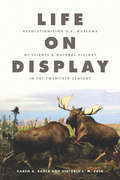- Table View
- List View
Life in the Dark: Illuminating Biodiversity in the Shadowy Haunts of Planet Earth
by Danté FenolioStunning, never-before-seen photographs of creatures that live in complete darkness.Honorable Mention for Technical Text of the Washington PublishersDeep inside caves, at the bottoms of oceans and lakes, beneath the ground: these concealed habitats are absent of sunlight. This strange and fascinating world of complete darkness is not a solitary place—it is inhabited by millions of life forms. Yet most humans—creatures of daylight—have never seen any of them. Until now. In this fascinating—sometimes eerie—book, extreme wildlife photographer and scientist Danté Fenolio brings the denizens of these shadowy haunts into focus. Life in the Dark shows us the many ways in which life forms have adapted to lightless environments, including refinements of senses, evolution of unique body parts, and illumination using "biological flashlights." With more than 200 mesmerizing color photographs, Life in the Dark unveils bizarre creatures like the firefly squid, the giant Amazonian catfish, the Chinese cavefish, and even the human bot fly, which lives in the darkness beneath its host’s skin. Fenolio’s rich and vibrant images shed new light on the world’s fascinating creatures of darkness.
Life in the Dark: Illuminating Biodiversity in the Shadowy Haunts of Planet Earth
by Danté FenolioAn extreme wildlife photographer explores the bizarre species that thrive in complete darkness with more than 200mesmerizing color photos.Deep inside caves, at the bottoms of oceans and lakes, beneath the ground: these concealed habitats are absent of sunlight, and yet full of life. This strange world of complete darkness is inhabited by millions of life forms that most humans have never seen. Now Danté Fenolio brings the denizens of these shadowy haunts into focus. Life in the Dark shows us the many ways in which life forms have adapted to lightless environments, including refinements of senses, evolution of unique body parts, and illumination using “biological flashlights.”Discover fascinating creatures like the firefly squid, the giant Amazonian catfish, the Chinese cavefish, and even the human bot fly, which lives in the darkness beneath its host’s skin. Fenolio’s rich and vibrant images shed new light on the world’s fascinating creatures of darkness.
Life in the Frozen State
by Nick Lane Barry J. Fuller Erica E. BensonWhile it is barely 50 years since the first reliable reports of the recovery of living cells frozen to cryogenic temperatures, there has been tremendous growth in the use of cryobiology in medicine, agriculture, horticulture, forestry, and the conservation of endangered or economically important species.As the first major text on cryobiolog
Life in the Himalaya: An Ecosystem at Risk
by Maharaj K. PanditThe collision of the Indian and Eurasian plates 50 million years ago created the Himalaya, along with massive glaciers, intensified monsoon, turbulent rivers, and an efflorescence of ecosystems. Today, the Himalaya is at risk of catastrophic loss of life. Maharaj Pandit outlines the mountain’s past in order to map a way toward a sustainable future.
Life in the Open Ocean: The Biology of Pelagic Species
by Joseph J. Torres Thomas G. BaileyLife in the Open Ocean Life in the Open Ocean: The Biology of Pelagic Species provides in-depth coverage of the different marine animal groups that form the communities inhabiting the ocean’s pelagic realm. This comprehensive resource explores the physical environment, foraging strategies, energetics, locomotion, sensory mechanisms, global and vertical distributions, special adaptations, and other characteristics of a wide array of marine taxa. Bringing together the most recent information available in a single volume, authors Joseph J. Torres and Thomas G. Bailey cover the Cnidaria (stinging jellies), the ctenophores (comb jellies), pelagic nemerteans, pelagic annelids, crustaceans, cephalopods and pelagic gastropods, invertebrate chordates, as well as micronektonic and larger fishes such as sharks, tunas, mackerels, and mahi-mahi. Detailed chapters on each pelagic group describe internal and external anatomy, classification and history, feeding and digestion, bioluminescent systems and their function, reproduction and development, respiration, excretion, nervous systems, and more. The first book of its kind to address all of the major animal groups comprising both the swimmers and drifters of the open sea, this important resource: Explains how different animals have adapted to live in the open-ocean environment Covers all sensory mechanisms of animals living in the pelagic habitat, including photoreception, mechanoreception, and chemoreception Treats the diverse micronekton assemblage as a community Includes a thorough introduction to the physical oceanography and properties of water in the pelagic realm Life in the Open Ocean: The Biology of Pelagic Species is an excellent senior-level undergraduate and graduate textbook for courses in biology and biological oceanography, and a valuable reference for all those with interest in open-ocean biology.
Life in the Rain Forest
by Christine A. CaputoLearn more about rain forests, and the unique plants and animals that live in them.
Life in the Soil: A Guide for Naturalists and Gardeners
by James B. NardiLeonardo da Vinci once mused that "we know more about the movement of celestial bodies than about the soil underfoot," an observation that is as apt today as it was five hundred years ago. The biological world under our toes is often unexplored and unappreciated, yet it teems with life. In one square meter of earth, there lives trillions of bacteria, millions of nematodes, hundreds of thousands of mites, thousands of insects and worms, and hundreds of snails and slugs. But because of their location and size, many of these creatures are as unfamiliar and bizarre to us as anything found at the bottom of the ocean. Life in the Soil invites naturalists and gardeners alike to dig in and discover the diverse community of creatures living in the dirt below us. Biologist and acclaimed natural history artist James B. Nardi begins with an introduction to soil ecosystems, revealing the unseen labors of underground organisms maintaining the rich fertility of the earth as they recycle nutrients between the living and mineral worlds. He then introduces readers to a dazzling array of creatures: wolf spiders with glowing red eyes, snails with 120 rows of teeth, and 10,000-year-old fungi, among others. Organized by taxon, Life in the Soil covers everything from slime molds and roundworms to woodlice and dung beetles, as well as vertebrates from salamanders to shrews. The book ultimately explores the crucial role of soil ecosystems in conserving the worlds above and below ground. A unique and illustrative introduction to the many unheralded creatures that inhabit our soils and shape our environment above ground, Life in the Soil will inform and enrich the naturalist in all of us.
Life in the Soil: A Guide for Naturalists and Gardeners
by James B. NardiLeonardo da Vinci once mused that “we know more about the movement of celestial bodies than about the soil underfoot,” an observation that is as apt today as it was five hundred years ago. The biological world under our toes is often unexplored and unappreciated, yet it teems with life. In one square meter of earth, there lives trillions of bacteria, millions of nematodes, hundreds of thousands of mites, thousands of insects and worms, and hundreds of snails and slugs. But because of their location and size, many of these creatures are as unfamiliar and bizarre to us as anything found at the bottom of the ocean. Lavishly illustrated with nearly three hundred color illustrations and masterfully-rendered black and white drawings throughout, Life in the Soil invites naturalists and gardeners alike to dig in and discover the diverse community of creatures living in the dirt below us. Biologist and acclaimed natural history artist James B. Nardibegins with an introduction to soil ecosystems, revealing the unseen labors of underground organisms maintaining the rich fertility of the earth as they recycle nutrients between the living and mineral worlds. He then introduces readers to a dazzling array of creatures: wolf spiders with glowing red eyes, snails with 120 rows of teeth, and 10,000-year-old fungi, among others. Organized by taxon, Life in the Soil covers everything from slime molds and roundworms to woodlice and dung beetles, as well as vertebrates from salamanders to shrews. The book ultimately explores the crucial role of soil ecosystems in conserving the worlds above and below ground. A unique and illustrative introduction to the many unheralded creatures that inhabit our soils and shape our environment aboveground, Life in the Soil will inform and enrich the naturalist in all of us.
Life in the Universe (Third Edition)
by Jeffrey O. Bennett Seth ShostakLife in the Universe takes non-science majors on a journey through the solar system and beyond, using a rigorous yet accessible introduction to astronomy, biology, and geology to explain natural phenomena and to explore profound scientific questions about astrobiology. The Third Edition has been thoroughly revised to include updated scientific discoveries, new Cosmic Context two-page spreads, and an updated Companion Website. Designed for astrobiology courses but also suitable for introductory astronomy courses, Life in the Universe captures your imagination by exploring fundamental pan-scientific questions: What is life? How did life begin on Earth? What are the most extreme forms of life currently known? Is it reasonable to imagine life beyond Earth? The text motivates you to develop basic reasoning skills and an understanding of the process of science through skillful writing and a wealth of pedagogical features, such as Learning Goals that keep you focused on key concepts. Sidebars provide optional mathematical material for courses that fulfill quantitative requirements.
Life in the Universe, 5th Edition
by Seth Shostak Jeffrey Bennett Nicholas Schneider Meredith MacGregorThe world’s leading textbook on astrobiology—ideal for an introductory one-semester course and now fully revised and updatedAre we alone in the cosmos? How are scientists seeking signs of life beyond our home planet? Could we colonize other planets, moons, or even other star systems? This introductory textbook, written by a team of four renowned science communicators, educators, and researchers, tells the amazing story of how modern science is seeking the answers to these and other fascinating questions. They are the questions that are at the heart of the highly interdisciplinary field of astrobiology, the study of life in the universe.Written in an accessible, conversational style for anyone intrigued by the possibilities of life in the solar system and beyond, Life in the Universe is an ideal place to start learning about the latest discoveries and unsolved mysteries in the field. From the most recent missions to Saturn’s moons and our neighboring planet Mars to revolutionary discoveries of thousands of exoplanets, from the puzzle of life’s beginning on Earth to the latest efforts in the search for intelligent life elsewhere, this book captures the imagination and enriches the reader’s understanding of how astronomers, planetary scientists, biologists, and other scientists make progress at the cutting edge of this dynamic field. Enriched with a wealth of engaging features, this textbook brings any citizen of the cosmos up to speed with the scientific quest to discover whether we are alone or part of a universe full of life.An acclaimed text designed to inspire students of all backgrounds to explore foundational questions about life in the cosmosCompletely revised and updated to include the latest developments in the field, including recent exploratory space missions to Mars, frontier exoplanet science, research on the origin of life on Earth, and moreEnriched with helpful learning aids, including in-chapter Think about It questions, optional Do the Math and Special Topic boxes, Movie Madness boxes, end-of-chapter exercises and problems, quick quizzes, and much moreSupported by instructor’s resources, including an illustration package and test bank, available upon request
Life in the Universe, 5th Edition
by Seth Shostak Jeffrey Bennett Nicholas Schneider Meredith MacGregorThe world’s leading textbook on astrobiology—ideal for an introductory one-semester course and now fully revised and updatedAre we alone in the cosmos? How are scientists seeking signs of life beyond our home planet? Could we colonize other planets, moons, or even other star systems? This introductory textbook, written by a team of four renowned science communicators, educators, and researchers, tells the amazing story of how modern science is seeking the answers to these and other fascinating questions. They are the questions that are at the heart of the highly interdisciplinary field of astrobiology, the study of life in the universe.Written in an accessible, conversational style for anyone intrigued by the possibilities of life in the solar system and beyond, Life in the Universe is an ideal place to start learning about the latest discoveries and unsolved mysteries in the field. From the most recent missions to Saturn’s moons and our neighboring planet Mars to revolutionary discoveries of thousands of exoplanets, from the puzzle of life’s beginning on Earth to the latest efforts in the search for intelligent life elsewhere, this book captures the imagination and enriches the reader’s understanding of how astronomers, planetary scientists, biologists, and other scientists make progress at the cutting edge of this dynamic field. Enriched with a wealth of engaging features, this textbook brings any citizen of the cosmos up to speed with the scientific quest to discover whether we are alone or part of a universe full of life.An acclaimed text designed to inspire students of all backgrounds to explore foundational questions about life in the cosmosCompletely revised and updated to include the latest developments in the field, including recent exploratory space missions to Mars, frontier exoplanet science, research on the origin of life on Earth, and moreEnriched with helpful learning aids, including in-chapter Think about It questions, optional Do the Math and Special Topic boxes, Movie Madness boxes, end-of-chapter exercises and problems, quick quizzes, and much moreSupported by instructor’s resources, including an illustration package and test bank, available upon request
Life in the Universe: A Beginner's Guide (Beginner's Guides)
by Lewis DartnellAstrobiology, the study of life and its existence in the universe, is now one of the hottest areas of both popular science and serious academic research, fusing biology, chemistry, astrophysics, and geology. In this masterful introduction, Lewis Dartnell explores its latest findings, and explores some of the most fascinating questions in science. What actually is 'life'? Could it exist on other planets? Could alien cells be based on silicon rather than carbon, or need ammonia instead of water? Introducing some of the most extreme lifeforms on Earth - those thriving in boiling acid or huddled around deep-sea volcanoes - Dartnell takes us on a tour of the universe to reveal how deeply linked we are to our cosmic environment, and shows why the Earth is so uniquely suited for the development of life.
Life in the Universe: An Assessment of U.S. and International Programs in Astrobiology
by Committee on the Origins Evolution Of LifeAn Assessment of U.S. and International Programs in Astrobiology
Life in the Universe: Expectations and Constraints (Springer Praxis Books)
by Dirk Schulze-Makuch Louis N. IrwinExamines each of these parameters in crucial depth and makes the argument that life forms we would recognize may be more common in our solar system than many assume. Considers exotic forms of life that would not have to rely on carbon as the basic chemical element, solar energy as the main energy source, or water as the primary solvent and the question of detecting bio- and geosignatures of such life forms, ranging from earth environments to deep space. Seeks an operational definition of life and investigate the realm of possibilities that nature offers to realize this very special state of matter. Avoids scientific jargon wherever possible to make this intrinsically interdisciplinary subject understandable to a broad range of readers.
Life is Simple: How Occam's Razor Set Science Free And Unlocked the Universe
by JohnJoe McFaddenLife is Simple tells the remarkable story of how a thirteenth century monk's search for simplicity led to the emergence of the modern world.We begin in the turbulent times of the medieval friar, William of Occam, who first articulated the principle that the best answer to any problem is the simplest. This theory, known as Occam's razor, cut through the thickets of medieval metaphysics to clear a path for modern science. We follow the razor in the hands of the giants of science, from Copernicus, to Kepler, Galileo, Newton, Darwin, Einstein, Rubin and Higgs. Its success suggests that we live in the simplest possible habitable universe and supports the revolutionary theory that our cosmos has evolved.By highlighting the very human passion, curiosity, mistakes and struggles of those who were inspired by Occam's razor to create the modern world, Johnjoe McFadden provides new insight into what science is really about. And that the principle of simplicity is as relevant today as ever..
Life is Simple: How Occam's Razor Set Science Free And Unlocked the Universe
by JohnJoe McFaddenLife is Simple tells the remarkable story of how a thirteenth century monk's search for simplicity led to the emergence of the modern world.We begin in the turbulent times of the medieval friar, William of Occam, who first articulated the principle that the best answer to any problem is the simplest. This theory, known as Occam's razor, cut through the thickets of medieval metaphysics to clear a path for modern science. We follow the razor in the hands of the giants of science, from Copernicus, to Kepler, Galileo, Newton, Darwin, Einstein, Rubin and Higgs. Its success suggests that we live in the simplest possible habitable universe and supports the revolutionary theory that our cosmos has evolved.By highlighting the very human passion, curiosity, mistakes and struggles of those who were inspired by Occam's razor to create the modern world, Johnjoe McFadden provides new insight into what science is really about. And that the principle of simplicity is as relevant today as ever.(P) 2021 Hodder & Stoughton Limited
Life of Fred Chemistry
by Stanley F. SchmidtThis is the high school chemistry course that I wish I had when I was first studying chemistry. Several studies have shown that students who have had a high school chemistry course--like this book--do much better learning college-level chemistry. <p><p>The TRADITIONAL WAY to teach chem (and math and physics and biology) is have the student memorize thousands of facts. Some chem textbooks are like telephone books. One of them is actually 1200 pages long and costs more than $200. If you were teaching chem to a computer, this approach would be perfect. Computers can memorize (and retain) a million facts without breaking into a sweat.
Life of Fred: Pre-Algebra 1 with Biology
by Stanley F. SchmidtDefinition of Life, Sets, Fractions, Germination of Seeds, Area of a Rectangle, Volume of a Cube, Ordinal Numbers, Diameter and Circumference of a Circle, Definition of π, 2% of 500, Four Ways Plants Make New Plants, d = rt, 20% Discount, the Five Kingdoms, Phyla, Classes, Orders, Families, Genera, Species, Your Brain, Conversion Factors, Where the Non-Water Mass of a Plant Comes From—Plants Don’t Eat Dirt, Subsets of Sets, Digestion, Eyes, Negative Numbers, Dominant Genes, Genotypes, Phenotypes, Blood, Staying Alive, Solving Algebraic Equations, Volume of a Cylinder, Word Problems, Breathing, Chlorophyll vs. Hemoglobin vs. Hemocyanin, Avogadro’s Number, Stoichiometry, the Whole Numbers, a Proof that Division by Zero is Not Permitted, Bones, the Integumentary System, Epidermis and Dermis, Meiosis and Mitosis, Chromosomes, DNA, Alleles, Changing Your Phenotype.
Life of Inland Waters: An Elementary Text Book of Fresh-Water Biology For Students
by James G. NeedhamThis work is a textbook of fresh-water life dealing with its forms, its conditions, its fitnesses, its associations, and its economic aspects. The ecologic side of fresh-water biology is emphasized. Due consideration is given to the educational, economic, sanitary, social, civic, and aesthetic aspects of the subject.Limnology in America today is in its infancy. The value of its past achievements is just beginning to be appreciated. The benefits to come from a more intensive study of water life arc just beginning to be disclosed. That there is a widespread interest is already manifest in the large number of biological stations at which limnological work is being done.We recommend this volume as a general introduction to all students and teachers of this subject.
Life of a Fossil Hunter
by Charles Hazelius SternbergThis work has been selected by scholars as being culturally important and is part of the knowledge base of civilization as we know it. This work is in the public domain in the United States of America, and possibly other nations. Within the United States, you may freely copy and distribute this work, as no entity (individual or corporate) has a copyright on the body of the work. Scholars believe, and we concur, that this work is important enough to be preserved, reproduced, and made generally available to the public. To ensure a quality reading experience, this work has been proofread and republished using a format that seamlessly blends the original graphical elements with text in an easy-to-read typeface. We appreciate your support of the preservation process, and thank you for being an important part of keeping this knowledge alive and relevant.
Life of the Past (4th Edition)
by William I. Ausich N. Gary LaneA comprehensive introduction to the history of life on Earth.
Life on Display: Revolutionizing U.S. Museums of Science and Natural History in the Twentieth Century
by Karen A. Rader Victoria E. M. CainRich with archival detail and compelling characters, Life on Display uses the history of biological exhibitions to analyze museums’ shifting roles in twentieth-century American science and society. Karen A. Rader and Victoria E. M. Cain chronicle profound changes in these exhibitions--and the institutions that housed them--between 1910 and 1990, ultimately offering new perspectives on the history of museums, science, and science education. Rader and Cain explain why science and natural history museums began to welcome new audiences between the 1900s and the 1920s and chronicle the turmoil that resulted from the introduction of new kinds of biological displays. They describe how these displays of life changed dramatically once again in the 1930s and 1940s, as museums negotiated changing, often conflicting interests of scientists, educators, and visitors. The authors then reveal how museum staffs, facing intense public and scientific scrutiny, experimented with wildly different definitions of life science and life science education from the 1950s through the 1980s. The book concludes with a discussion of the influence that corporate sponsorship and blockbuster economics wielded over science and natural history museums in the century’s last decades. A vivid, entertaining study of the ways science and natural history museums shaped and were shaped by understandings of science and public education in the twentieth-century United States, Life on Display will appeal to historians, sociologists, and ethnographers of American science and culture, as well as museum practitioners and general readers.
Life on Display: Revolutionizing U.S. Museums of Science and Natural History in the Twentieth Century
by Karen A. Rader Victoria E.M. CainRich with archival detail and compelling characters, Life on Display uses the history of biological exhibitions to analyze museums’ shifting roles in twentieth-century American science and society. Karen A. Rader and Victoria E. M. Cain chronicle profound changes in these exhibitions—and the institutions that housed them—between 1910 and 1990, ultimately offering new perspectives on the history of museums, science, and science education. Rader and Cain explain why science and natural history museums began to welcome new audiences between the 1900s and the 1920s and chronicle the turmoil that resulted from the introduction of new kinds of biological displays. They describe how these displays of life changed dramatically once again in the 1930s and 1940s, as museums negotiated changing, often conflicting interests of scientists, educators, and visitors. The authors then reveal how museum staffs, facing intense public and scientific scrutiny, experimented with wildly different definitions of life science and life science education from the 1950s through the 1980s. The book concludes with a discussion of the influence that corporate sponsorship and blockbuster economics wielded over science and natural history museums in the century’s last decades. A vivid, entertaining study of the ways science and natural history museums shaped and were shaped by understandings of science and public education in the twentieth-century United States, Life on Display will appeal to historians, sociologists, and ethnographers of American science and culture, as well as museum practitioners and general readers.
